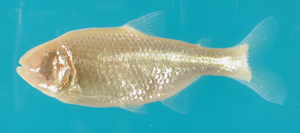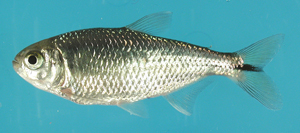Blind Cavefish Offer Evidence for Alternative Mechanism of Evolutionary Change

WOODS HOLE, Mass.—In a blind fish that dwells in deep, dark Mexican caves, scientists have found evidence for a long-debated mechanism of evolutionary change that is distinct from natural selection of spontaneously arising mutations, as reported this week in the journal Science.
 The eyeless cavefish Astyanas mexicanus. These fish begin to develop eyes but then lose them as the embryo matures. They are also depigmented, unlike their surface-dwelling ancestors. This is one of the few cave animals in which the surface-dwelling ancestor is not extinct, which allows scientists to compare them genetically. Credit: William Jeffery
The eyeless cavefish Astyanas mexicanus. These fish begin to develop eyes but then lose them as the embryo matures. They are also depigmented, unlike their surface-dwelling ancestors. This is one of the few cave animals in which the surface-dwelling ancestor is not extinct, which allows scientists to compare them genetically. Credit: William JefferyThe eyeless cavefish Astyanas mexicanus is “a special system in which we can look at evolution in action,” says article co-author William Jeffery, a senior adjunct scientist at the Marine Biological Laboratory (MBL) in Woods Hole, Mass., and a professor at the University of Maryland. The Science study was led by Nicolas Rohner and Clifford J. Tabin at Harvard Medical School’s Department of Genetics.
Using the cavefish, the team demonstrated for the first time in nature how “standing” or “cryptic” genetic variations in an animal, which have been inherited from prior generations without causing any physical changes in the animal, can be “unmasked” by the shock of entering a new environment. Gene variants that improve the animal’s ability to adapt to that new environment can then be selected for, and passed on to its progeny. This is distinct from the established evolutionary mechanism of “de novo” genetic mutations that arise by chance after the animal has entered the new environment, which also provide a substrate upon which natural selection can act.
 The surface-dwelling Astyanas mexicanus, which has eyes and pigmentation. Credit: William Jeffery
The surface-dwelling Astyanas mexicanus, which has eyes and pigmentation. Credit: William JefferyThe environmental shock that prompted the loss of eyes in the cavefish, the scientists propose, occurred about 2 or 3 million years ago when its surface-dwelling ancestors, which have eyes, “either colonized these caves or were trapped in them,” Jeffery says. The fish’s transition from swimming outside the cave to swimming inside the cave, where the water is purer and less conductive of electricity, inhibited the activity of a “heat shock” protein called HSP90. (Prior studies in the fruit fly of this protein, which is critical in regulating protein folding, had suggested that it may play a role in masking cryptic genetic variation.) In the case of the cavefish, the present study finds, HSP90 inhibition due to environmental shock unmasked cryptic genetic variations, allowing smaller or bigger eyes to be expressed in different individuals.
“On the surface, in an environment of light, bigger eyes are more helpful than tiny eyes. But once the fish gets into the cave, if that (genetic variation) is unmasked, it doesn’t matter if you have small eyes or big eyes because it is completely dark,” Jeffery says. The paper suggests that fish that expressed smaller eyes, and eventually no eyes, were selected for because it provided an adaptive advantage.
“That is controversial,” Jeffery says, noting that it is difficult even for scientists in the field to conceive of the purpose of losing eyes. The paper proposes several possible advantages of eyelessness, such as allowing the animal to conserve the large amount of energy it takes to maintain an eye and to expend it, instead, on traits that are useful in a dark environment.
 Jeffery lab (University of Maryland) collaborators Helena Bilandzija and Branko Jalzic at a cave in the northeastern Mexican mountains where Astyanas mexicanus live. Jeffery led the expeditions that collected the fish and measured the cave water for this study. Credit: William Jeffery
Jeffery lab (University of Maryland) collaborators Helena Bilandzija and Branko Jalzic at a cave in the northeastern Mexican mountains where Astyanas mexicanus live. Jeffery led the expeditions that collected the fish and measured the cave water for this study. Credit: William JefferyThe descent of the surface-dwelling Astyanas mexicanus into the cave a few million years ago “is a very, very recent event, in evolutionary terms,” Jeffery says. “We are talking about a rapid evolutionary process here, as opposed to the 500 million years of natural selection that have unfolded since most animal [groups] appeared during the Cambrian Period. The fact that these eyeless cavefish are so young makes them very attractive to understand evolutionary processes at their beginning.”
Citation:
Rohner H, Jarosz DF, Kowalko JE, Yoshizawa M, Jeffery WR, Borowsky RL, Lindquist S, and Tabin CJ (2013) Cryptic variation in morphological evolution: HSP90 as a capacitor for loss of eyes in a cavefish. Science 342: 1372-1375 DOI: 10.1126/science.1240276
—###—
The Marine Biological Laboratory (MBL) is dedicated to scientific discovery and improving the human condition through research and education in biology, biomedicine, and environmental science. Founded in Woods Hole, Massachusetts, in 1888, the MBL is a private, nonprofit institution and an affiliate of the University of Chicago.